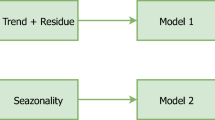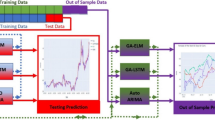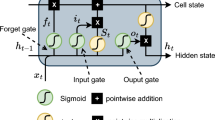Abstract
Interest in the subject of prediction has increased in recent years, and modern and advanced methods have emerged, including neural network models, chaotic algorithms, hybrid algorithms, and others. All of these methods are able to learn and self-adapt to any model and do not need assumptions for the nature of the time series. Taking more than one method may lead to an increase in the accuracy of future estimates, so a neural network and chaotic genetic algorithms are used, so a model combines the strengths of two techniques to develop a hybrid CGANN model to obtain more accurate prediction results and reduce prediction errors. The aim of this study is to shed light on some of the statistical methods used in predicting the future demand for electric power in the southern region, as well as pointing to the most accurate methods in predicting the future of energy. The annual electrical energy consumption data for the southern region were used to make a comparison through practical application, and it was found that the three methods are very high accuracy and suitable for use in the prediction process, but the most accurate models are the hybrid algorithm consisting of neural networks and the chaotic genetic algorithm CGANN that gives better and more results efficient and thus, was used to predict the electrical load of the southern region up to 2032.





Similar content being viewed by others
Data availability
Data will be provided based on the request.
Change history
21 July 2023
A Correction to this paper has been published: https://doi.org/10.1007/s00500-023-09003-0
References
Abdel Gader AA, Hussein Al-W Kh (2015) Prediction of the monthly averages of maximum and minimum temperatures in the city of Baghdad by using multi-layer neural networks. Al-Rafidain University College of science journal
Abdul-Jalil E, Shaker A (2018) Studying the effect of changing the parameters of the chaotic genetic algorithm on the optimal solutions in the design of drinking water networks, Hama Univ J, 1(2), Syria
Al-Badran PR, Imad SR (2014) Evaluation of time series prediction of heat rates using neural networks. Iraqi J Statist Sci 26:7
Al-Thalabi SHZ, Imran Kh M (2016) Determining the best model for predicting electric energy consumption in the southern region. J Econ Sci 22(90)
Al-Wasifi ShIS (2012) Predicting using the integration of artificial neural networks, box and jenkins models (applied study), Memorandum submitted as part of the requirements for obtaining a master’s degree in Applied Statistics, Mansoura University, Egypt
Begum SA, Fujail AK, Barbhuiya AK (2012) Artificial neural network to predict equilibrium local scour depth around semicircular bridge abutments. In: 6th international symposium on advances in science and technology, Kuala Lumpur, Malaysia
Brambilla A (2014) Distillation control and optimization, McGraw-Hill Education
Cain G (2017) Artificial neural networks: new research. Nova Science Publishers, New York
Coakley JR, Brown CE (2000) Artificial neural networks in accounting and finance: modeling issues. Int J Intell Syst Account, Finance Manag 9(2):119–144
Deng Y, Xiang J, Ou Z (2012) SVR with hybrid chaotic genetic algorithm for short-term traffic flow forecasting. In: 2012 8th international conference on natural computation
Deng N, Tian Y, Zhang C (2013) Support vector machines optimization based theory algorithms, and extensions, University of minnesota department of computer science and engineering minneapolis, Minnesota
Du Ke-Lin M, Swamy NS (2014) Neural networks and statistical learning. Springer-Verlag, London
Grigoryan H (2015) Stock market prediction using artificial neural networks. Case study of TAL1T, Nasdaq OMX baltic stock, Database Syst J. VI(2)
Jha GK (2007) Artificial neural networks and its applications, J Indian Agric Res Ins. V41–V49
Krose B, Smaget PV (1996) An introduction to neural networks, University of Amsterdam, 8th edn. Netherlands
Lü Q, Shen G, Yu R (2003) A chaotic approach to maintain the population diversity of genetic algorithm in network training. Comput Biol Chem 27(3):363
Moreno JJM, Pol AP, Gracia PM (2011) Artificial neural networks applied to forecasting time series. Universidad De Las Islas Baleares Universidad Politecnica De Cataluna 23(2):322–329
Ramadan MZ, Ibrahim EA (2010) Analysis and modeling of the time series of water flow entering the city of Mosul—a comparative study. Iraqi J Statist Sci. Issue 18
Shen HY, Chang LC (2013) Online multistep-ahead inundation depth forecasts by recurrent NARX networks
Taylor JB (2006) Methods and procedures for verification and validation of artificial neural networks, Springer
Xu Z, Gao Y, Jin Y (2014) Application of an optimized SVR model of machine learning, College of finance, hebei normal university of science and technology, Qinhuangdao, Hebei. 9(6)
Yu L, Wang S, Lai K (2007) An online learning algorithm with adap- tive forgetting factors for forward neural networks in _nancial time series forecasting. online
Acknowledgements
No acknowledge
Funding
No funding is involved in this work.
Author information
Authors and Affiliations
Contributions
There is no authorship contribution.
Corresponding author
Ethics declarations
Conflict of interest
Conflict of Interest is not applicable in this work.
Ethics approval and consent to participate
No participation of humans takes place in this implementation process.
Human and animal rights
No violation of Human and Animal Rights is involved.
Additional information
Publisher's Note
Springer Nature remains neutral with regard to jurisdictional claims in published maps and institutional affiliations.
The original article has been updated: Due to first author name update.
Rights and permissions
Springer Nature or its licensor (e.g. a society or other partner) holds exclusive rights to this article under a publishing agreement with the author(s) or other rightsholder(s); author self-archiving of the accepted manuscript version of this article is solely governed by the terms of such publishing agreement and applicable law.
About this article
Cite this article
AL-Thalabi, S.H.Z., Heydari, A.A. & Tavakoli, M. Optimization of hybridization of artificial neuron with chaotic genetic algorithm in prediction process/with the application. Soft Comput (2023). https://doi.org/10.1007/s00500-023-08727-3
Accepted:
Published:
DOI: https://doi.org/10.1007/s00500-023-08727-3




